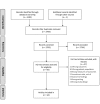Place of death, care-seeking and care pathway progression in the final illnesses of children under five years of age in sub-Saharan Africa: a systematic review
- PMID: 31673338
- PMCID: PMC6815655
- DOI: 10.7189/jogh.09.020422
Place of death, care-seeking and care pathway progression in the final illnesses of children under five years of age in sub-Saharan Africa: a systematic review
Abstract
Background: Half of all under-5 deaths occur in sub-Saharan Africa. Reducing child mortality requires understanding of the modifiable factors that contribute to death. Social autopsies collect information about place of death, care-seeking and care-provision, but this has not been pooled to learn wider lessons. We therefore undertook a systematic review to collect, evaluate, map, and pool all the available evidence for sub-Saharan Africa.
Methods: We searched PubMed, Embase, Global Health, the Cochrane Library and grey literature for studies relating to under-5 deaths in sub-Saharan Africa with information on place of death and/or care-seeking during a child's final illness. We assessed study quality with a modified Axis tool. We pooled proportions using random effects meta-analysis for place of death and for each stage of the Pathways to Survival framework. Pre-specified subgroup analysis included age group, national income and user-fee policy. We explored heterogeneity with meta-regression. Our protocol was published prospectively (CRD42018111484).
Results: We included 34 studies from 17 countries. Approximately half of the children died at home, irrespective of age. More children died at home in settings with user-fees (69.1%, 95% confidence interval (CI) = 56.2-80.6, I2 = 98.4%) compared to settings without user-fees (43.8%, 95% CI = 34.3-53.5, I2 = 96.7%). Signs of illness were present in over 95% of children but care-seeking differed by age. 40.1% of neonates (95% CI = 20.7-61.3, I2 = 98.0%) died without receiving any care, compared to 6.4% of older children (95% CI = 4.2%-9.0%, I2 = 90.6%). Care-seeking outside the home was less common in neonatal deaths (50.5%, 95% CI = 35.6-65.3, I2 = 98.3%) compared to infants and young children (82.4%, 95% CI = 79.4%-85.2%, I2 = 87.5%). In both age groups, most children were taken for formal care. Healthcare facilities discharged 69.6% of infants and young children who arrived alive (95% CI = 59.6-78.7, I2 = 95.5%), of whom only 34.9% were referred for further care (95% CI = 15.1-57.9, I2 = 98.7%).
Conclusions: Despite similar distributions in place of death for neonates and infants and young children, care-seeking behaviour differed by age groups. Poor illness recognition is implicated in neonatal deaths, but death despite care-seeking implies inadequate quality care and referral for older children. Understanding such care-seeking patterns enables targeted interventions to reduce under-5 mortality across the region.
Copyright © 2019 by the Journal of Global Health. All rights reserved.
Conflict of interest statement
Competing interests: The authors completed the Unified Competing Interest form at www.icmje.org/coi_disclosure.pdf (available upon request from the corresponding author), and declare no conflicts of interest.
Figures







References
-
- United Nations Inter-agency Group for Child Mortality Estimation. (UN, IGME). ‘Levels & Trends in Child Mortality: Report 2018, Estimates developed by the United Nations Inter-agency Group for Child Mortality Estimation. 2018. Available: https://data.unicef.org/wp-content/uploads/2018/10/Child-Mortality-Repor.... Accessed: 19 March 2019.
-
- UNICEF. The State of the World’s Children 2017: Children in a Digital World. 2017. Available: https://www.unicef.org/publications/files/SOWC_2017_ENG_WEB.pdf. Accessed: 25 June 2019.
-
- Sustainable Development Goals. 17 goals to transform our world. 2015. Available: http://www.un.org/sustainabledevelopment/health/. Accessed 5 January 2016.
Publication types
MeSH terms
LinkOut - more resources
Full Text Sources
Medical
